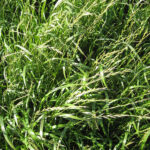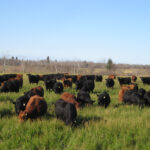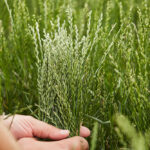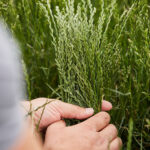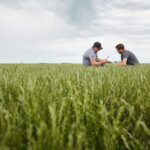Perennial Ryegrass
Lolium perenne
General Description
Perennial ryegrass is a short-lived, perennial, cool season bunchgrass. Perennial ryegrass is best suited to areas with cool summers of reasonable moisture without summer drought, and mild winters. It is grown mainly as an annual in western Canada, but as a perennial in southern BC. It is closely related to Italian ryegrass, but is smaller, has folded rather than rolled leaves, and lacks awns.
Perennial ryegrass produces a shallow, fibrous root system, with the majority of roots in the upper 15 cm (6 in) of soil. It tillers freely and produces a dense sod. Perennial ryegrass produces a dense cover of low-growing leaves, and stems that are up to 60 cm (24 in) long with a slender spike up to 30 cm (12 in) long. Leaves are dark green, narrow, hairless, keel-shaped, and folded when young. Lower surface is glossy and smooth, while upper surface is veined and duller coloured.
There are diploid and tetraploid genetic types (double chromosome types often associated with more vigorous growth but less hardiness) with a tremendous variation in seed size both between and within genetic types. Turf-type perennial ryegrass is not suited for forage use because they are low growing and low yielding – choose a forage-type perennial ryegrass. Crosses between perennial ryegrass and fescues exist.
Perennial ryegrass is a short-lived, perennial, cool season bunchgrass. Perennial ryegrass is best suited to areas with cool summers of reasonable moisture without summer drought, and mild winters. It comes in turf-, pasture- and hay-adapted varieties. The pasture-adapted varieties tend to have finer leaves, smaller and more numerous tillers, and later maturity than the hay varieties. Perennial ryegrass produces a shallow, fibrous root system, with the majority of roots in the upper 15 cm (6 in) of soil. It tillers freely and produces a dense sod.
Perennial ryegrass produces a dense cover of low-growing leaves, and stems that are up to 60 cm (24 in) long with a slender spike up to 30 cm (12 in) long. Leaves are dark green, narrow, hairless, keel-shaped, and folded when young. Lower surface is glossy and smooth, while upper surface is veined and duller coloured.
There are diploid and tetraploid genetic types (double chromosome types often associated with more vigorous growth but less hardiness) with a tremendous variation in seed size both between and within genetic types. Turf-type perennial ryegrass is not suited for forage use because they are low growing and low yielding – choose a forage-type perennial ryegrass. Crosses between perennial ryegrass and fescues exist (see Festulolium). Fertility & moisture needed for high yield.
Type
Tame grass.
Origin
Europe. It is sometimes called English ryegrass.
Longevity
Less than 5 years. Annual in most of western Canada. Short lived in southern British Columbia.
Less than 5 years.
Use
Pasture, saliage, hay. Perennial ryegrass grows quickly so it is well suited for use in pastures, usually under short-term intensively managed grazing and fertilized, irrigated pastures. Can be hayed but tends to be low growing and slow to dry.
Optimal Time of Use
Spring, summer, fall. Perennial ryegrass can be used 2+ months after seeding. Perennial ryegrass produces high quality forage but requires good fertility.
Recovery After Use
Recovery can occur within 30-45 days. Perennial ryegrass can be frequently grazed close to the ground and is adapted for either continuous or rotational grazing systems. Perennial ryegrass requires high fertilizer inputs.
Perennial ryegrass can be frequently grazed close to the ground and is adapted for either continuous or rotational grazing systems. Perennial ryegrass requires high fertilizer inputs.
Palatability/Nutritional Value
Very palatable as perennial ryegrass can be one of the highest quality forage grasses for grazing. Precautions need to be taken to test forage for endophytes and a toxin called lolitrem B, especially if feeding perennial grass seed straws from varieties favoured by the turf industry.
Annual Precipitation min/max (mm)
400mm / 600mm. USDA indicates it withstands up to 65 inches/year.
Drought Tolerance
Poor tolerance. Perennial ryegrass is very intolerant of drought or high temperatures.
Flooding Tolerance
Withstands 1-2 weeks of spring flooding. Moisture is critical for perennial ryegrass success.
Winter Hardiness
Poor hardiness. Usually grown as an annual because lacks winter hardiness.
Poor hardiness. Do not apply nitrogen after July on the forage types of perennial ryegrass. This appears to lower their overwintering ability — a problem associated with perennial ryegrass in Ontario.
Soil Texture Preference
Loamy to clay soils. Moisture must not be limited.
Erosion Control
Moderate erosion control. Perennial ryegrass is used often in turf and conservation mixes because of its quick green growth and ground cover, early in the year of establishment.
Salinity Tolerance
Slight tolerance.
Acidity Tolerance
Moderate tolerance. Perennial ryegrass produces and thrives best on neutral soils.
Alkalinity Tolerance
Moderate tolerance.
Seeds per kg
530,000 seeds/kg (240,000 seeds/lb)
Suggested Mixtures
Often seeded in a pure stand. Compatible with alfalfa and clovers. Perennial ryegrass may be included in an erosion mix to provide quick cover in the year of establishment.
Ease of Establishment
Perennial ryegrass is easy to establish. It germinates quickly and can be vigorous enough to graze two months after emergence.
Competitiveness
High competitiveness as it produces a dense growth. Low invasiveness.
Management Considerations
If the goal is a longer term stand of perennial ryegrass it will need to be reseeded often (or patch seeded), it requires high fertility, and moisture must not be limited – irrigation is beneficial. Read seed mix labels carefully to understand if and when perennial ryegrass is included in the mix. Select a variety of the forage-type with a low amount of endophyte.
If the goal is a longer term stand of perennial ryegrass it will need to be reseeded often (or patch seeded), it requires high fertility, and moisture must not be limited. If irrigation is possible, consider pure stands of perennial ryegrass. Ryegrass responds well to nitrogen fertility, and the resulting yields could warrant the cost of irrigating. Do not apply nitrogen after July on the forage types of perennial ryegrass. This appears to lower their overwintering ability — a problem associated with perennial ryegrass in Ontario. Graze or cut off any fall growth before winter to lessen the likelihood of snow moulds developing and damaging the ryegrass. Read seed mix labels carefully to understand if and when perennial ryegrass is included in the mix. Select a variety of the forage-type with a low amount of endophyte.
British Columbia Rangeland Seeding Manual, Manitoba Forage Adaptation and Comparison Guide, USDA Plants Database, Alberta Forage Manual, Publication 30-OMAFRA
Perennial ryegrass is adapted to the Sub-Boreal Spruce, Interior Cedar-Hemlock and Sub-Boreal Pine-Spruce zones. In the southern part of the Central Interior region, it is adapted to wetter parts of the Interior Douglas-fir zone and to irrigated and subirrigated areas in the Bunchgrass zone and drier parts of the Interior Douglas-fir zone.
Perennial ryegrass is adapted to dryland applications in the wetter parts of the Interior Douglas-fir zone, the Interior Cedar-Hemlock zone, and to irrigated and subirrigated areas in the Bunchgrass, Ponderosa Pine zones and drier parts of the Interior Douglas-fir zone.
Perennial ryegrass is sometimes grown in the Peace-Liard region, although some varieties may not be long lived. Choose a variety known for winter-hardiness, and consider seeding objectives.
